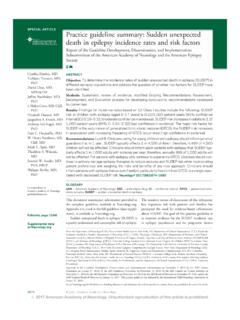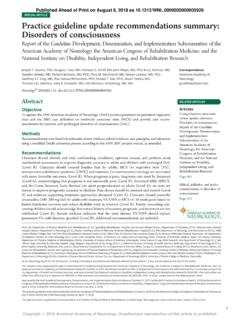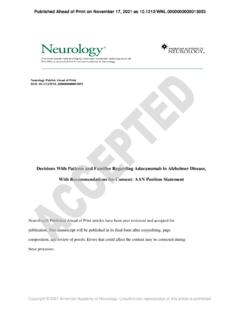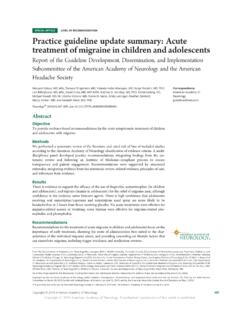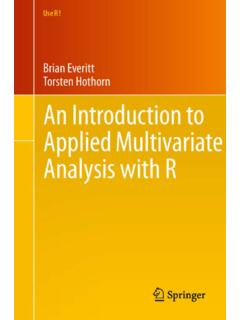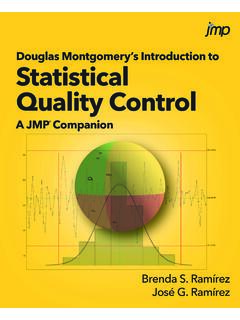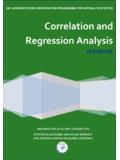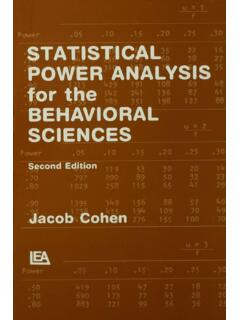Transcription of Semont maneuver vs Epley procedure - Neurology
1 VIDEOSelf-treatment of benignparoxysmal positional vertigoSemont maneuver vs Epley procedureA. Radtke, MD; M. von Brevern, MD; K. Tiel-Wilck, MD; A. Mainz-Perchalla, MD;H. Neuhauser, MD, MPH; and T. Lempert, MDAbstract The authors compared the efficacy of a self-applied modified Semont maneuver (MSM) with self-treatmentwith a modified Epley procedure (MEP) in 70 patients with posterior canal benign paroxysmal positional vertigo. Theresponse rate after 1 week, defined as absence of positional vertigo and torsional/upbeating nystagmus on positionaltesting, was 95% in the MEP group (n 37) vs 58% in the MSM group (n 33; p ).
2 Treatment failure was relatedto incorrect performance of the maneuver in the MSM group, whereas treatment-related side effects did not differsignificantly between the 2004;63:150 152 Posterior canal benignparoxysmal positional vertigo(PC-BPPV) is caused by dislodged otoconia that movewithin the PC whenever head position is changed. Theresulting endolymph flow activates hair cell receptors,causing short-lasting vertigo and a mixed torsional/upbeating nystagmus. This canalolithiasis hypothesishas been corroborated by the success of therapist-guided positioning maneuvers that aim to clear thePC of trapped particles.
3 In controlled trials, single ap-plications of the Epley procedure1or the Semont ma-neuver2relieved 70 to 90% of , thisindicates that some patients require repeated treat-ment until positional vertigo resolves , complementary self-treatment is a desirableoption to abort BPPV. We recently showed that self-treatment with a modified Epley procedure (MEP) re-lieved 64% of 28 patients within 1 week, whereas theSemont maneuver has not yet been evaluated for , we compared the efficacy of self-treatment with a modified Semont maneuver (MSM)and the and outpatients with unilateralPC-BPPV from a dizziness clinic and 29 patients from a neurolo-gist s practice were included according to the following criteria:1.
4 History of short-lasting ( 1 minute) rotational vertigo pre-cipitated by changes of head position;2. A mixed torsional/upbeating nystagmus beating toward theundermost ear elicited by positional testing in the lateral orhead-hanging position for 60 seconds7as observed withFrenzel glasses; and3. Reversal of torsional nystagmus on sitting who had received any positioning maneuver duringthe acute episode of BPPV, patients with bilateral or horizontalcanal BPPV, and patients who could not reliably perform self-treatment because of language problems or lack of mobility patients were eligible.
5 After giving informed con-sent according to the local ethics committee, patients were ran-domly assigned to apply MEP (n 42) or MSM (n 37). Fivepatients in the MEP group and four in the MSM group were lostto follow-up. Seven of these nine patients did not return for posi-tional testing, and two did not complete the exercise because ofconcurrent cardiac arrhythmia or a sore hip. Therefore, statisticalanalysis was performed on 70 patients (10 men, 60 women; age,35 to 80 years [mean, 60 12 years]).
6 The median duration ofacute BPPV was 8 weeks. BPPV was idiopathic in 55 patients oroccurred after head trauma (n 4) or vestibular disease (n 11).Age, sex, and mean duration of the acute episode did not differsignificantly between the two patients received an illustrated instruction with their spe-cific exercise for the affected ear (figure 1). The sequence of headand body movements was explained. Patients then performed themaneuver once under supervision of the instructing performed the exercise three times daily until positionalvertigo had ceased for at least 24 hours.
7 They indicated in a diarywhether positional vertigo occurred during each treatment sessionto determine the number of sessions needed for subjective relief ofvertigo and documented treatment-related side effects ( , nau-sea, gait imbalance, and dizziness). Successful treatment after 1week was defined as absence of positional vertigoandabsence ofnystagmus on positional testing. Patients were asked to performthe maneuver again on their second visit to assess accuracy oftreatment analysis included chi-squaretest for dichotomous variables andStudent st-test for continuousvariables for comparison between treatment groups.
8 Kaplan Meieranalysis, including log-rank test, was performed to test for differ-ences in number of treatment sessions completed until positionalAdditional material related to this article can be found on theNeurologyWeb site. Go to and scroll down the Table of Con-tents for the July 13 issue to find the title link for this also page 8 From the Neurologische Klinik der Charit , Campus Virchow Klinikum, Berlin, August 25, 2003. Accepted in final form February 17, correspondence and reprint requests to Dr.
9 Andrea Radtke, Neurologische Klinik der Charit , Campus Virchow-Klinikum, Augustenburger Platz 1,13353 Berlin, Germany; e-mail: 2004 by AAN Enterprises, resolved. Logistic regression was used for multivariate analy-sis. Ninety-five percent CIs are presented. A significance level of follow-up evaluation after 1 week, 35 of 37patients (95%; CI, 81 to 99%) in the MEP group wereasymptomatic and showed a negative positional test,whereas in the MSM group, only 19 of 33 patients (58%;CI, 39 to 75%) were cured (relative risk, ; CI, ).
10 Figure 2 shows the number of treatment sessionspatients performed until they felt relieved from positionalvertigo. The two groups did not differ significantly withrespect to treatment-related side effects. Seven of 37 pa-tients (19%; CI, 8 to 35%) in the MEP group and 12 of 33patients (36%; CI, 20 to 55%) in the MSM group performedthe maneuver incorrectly (p ). However, althoughincorrect performance had no effect on treatment outcomein the MEP group (p ), there were significantly moretreatment failures in the MSM group among patients whoperformed the maneuver incorrectly compared with thoseFigure 1.
